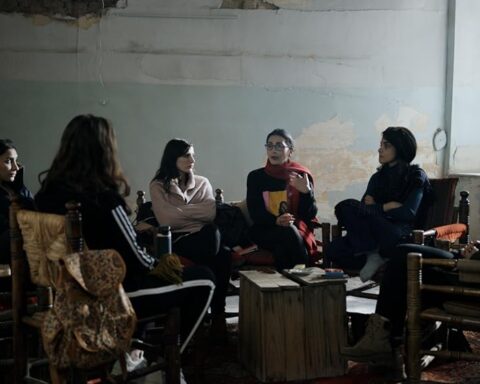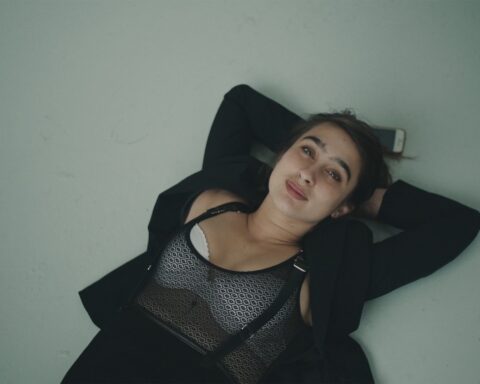There is probably somebody, somewhere, who could tell you definitively how many film festivals there are in Toronto. Most critics would tell you it feels like there are roughly a million, especially during the murderer’s row of the early spring months with Hot Docs, the Toronto Jewish Film Festival, Inside/Out and others vying for attention and column inches. Diversity is never a bad thing, of course, but the sheer abundance of choice can make it difficult, particularly for smaller festivals trying to carve out their own space.
Which is why the Canadian Art Reel Artists Film Festival makes for such an inspiring case study. Now in its sixth year, the festival, which is the brainchild of founder and curator Ann Webb, who says that she was inspired by Naples’ annual Artecinema programme, has cornered the market on contemporary documentaries about visual artists—a surprisingly hardy subgenre which, based on the 2009 lineup, is capable of transcending its general made-for-cable TV trappings.
“We have more and more feature-length documentaries,” says Webb in an interview conducted near the festival’s offices in downtown Toronto. “In the past, most of the films I showed were only about half an hour in length, because they were designed to be shown on television. But that seems to be changing.”
A case in point would be 2009’s opening night film, Megumi Sasaki’s smoothly produced crowd-pleaser Herb and Dorothy, which seems likely to receive a mainstream release. The film, which also showed at the Silverdocs festival, follows an elderly Manhattan couple who have built an international reputation over four decades of private art collecting, culminating in an exhibition of their work at the National Gallery of Art in Washington. “Don’t call them amateurs!” chides Webb when I ask her about the film’s eponymous subjects, whose endearingly low-key daily lives are smartly interwoven with admiring testimonies from the likes of Jeanne-Claude and Christo.
“Most people think that to participate in the art world, you have to be wealthy,” Webb continues. “But Herb and Dorothy Vogel epitomize what it means just to be interested and to be willing to make a commitment. They organized their lives around it. They lived together on her salary and spent his salary on art, and they continue to live in a one-bedroom apartment in New York. It’s an amazing story about what patronage and philanthropy really mean, and how possible it is for people to do it.”
This same sentiment underpins a lot of Webb’s programming. She acknowledges that the only thing harder than assembling an annual lineup of worthy films about visual artists is making the selection seem palatable to timorous viewers who wouldn’t know a Modigliani from a Matisse. “We want to be as accessible as possible while maintaining a certain level of quality in the programming. We want audiences to feel like they can enter the art world without being intimidated by it, even if they don’t know anything about the artist. In the past, I have shown films about artists whose work I didn’t think I particularly liked, and then seeing their process onscreen has changed my mind. If a film can do that for me, I think it can do it for just about anybody.”
One film that validates this faith is Michael Blackwood’s Georg Baselitz: Making Art After Auschwitz and Dresden. The septuagenarian German painter, whose work—particularly in the 1970s, when he was at the forefront of his homeland’s “neo-expressionist” movement—has been seen as challenging even by the gallery-circuit cognoscenti, was recently the subject of a retrospective at London’s Royal Academy of Arts. Blackwood’s film takes the form of a cinematic guided tour, with commentary by Baselitz and the exhibition’s curator. The pared-down functionality of the filmmaking allows for Baselitz’s work to seem all the more vibrant and dramatic. “[Blackwood] is sort of hard-core,” admits Webb. “He just goes straight ahead, shoots the art, and lets the artists talk. Some people might find it a little bit dry, but I love what he does.”
At the other end of the aesthetic spectrum lies Isaac Julien’s Derek, an affectionate tribute to the late British filmmaker Derek Jarman, which balances its conventional, chronological summation of its subject’s life and times with moody footage of Tilda Swinton walking through London. While Swinton’s self-penned voice-over can get a tad overwrought (she stresses the fact of Jarman’s artistry, as if it were a point of debate), the smartly integrated clips from Jarman’s oeuvre give the film a pleasing shape.
Jarman isn’t the only avant-garde cinema superstar to warrant a profile: Marina Zenovich’s short David Lynch: The Air is on Fire follows the Inland Empire auteur during an exhibition of his work in Milan. Like most documentaries about Lynch, the film benefits greatly from his well-rehearsed eccentricity, while Zenovich—whose last film about a pantheon filmmaker, Roman Polanski: Wanted and Desired, stirred considerable controversy by so obviously sympathizing with its exiled subject’s point of view—stays out of the way.
When asked if films like Julien’s and Zenovich’s have moved her to consider programming films by (as opposed to about) above-the-title directors whose work blurs boundaries between celluloid and visual art, Webb remains firm. She points out that Jarman and Lynch exhibited as painters before becoming acclaimed filmmakers. “I have been very strict and will continue to be very strict that the films are about visual artists,” she says. “There are a few reasons for this. One is that our organization, the Canadian Art Foundation, is about visual artists. But it’s also because I want to maintain our niche.
“There are other festivals that cover dance, music, and everything else. I don’t want to go there. I want to stay away from what the Images Festival in Toronto does, because they do it so well. We don’t really need another festival that shows artists’ films. We’re trying to counterbalance their programming. I want to stay focused on the visual, for now. That’s a reflection of my forte and background, and of the Canadian Art Foundation’s mandate.”
So far, this selectivity is working nicely: aided in no small part by its synergistic relationship with Canadian Art magazine—the foundation’s publication—Reel Artists has grown steadily since its inception. But, in the larger scheme of things, it’s still quite small—which is how Webb likes it.
“We don’t even have a box office,” she says. “We run it out of our offices, and this is the first year that I’ve had an assistant, Emma Cottreau, who has been fantastic.” The intimacy of the operation means that Webb, who attends every screening that she can, has come to actually recognize audience members who return from year to year. “It’s a niche market, but we have a very dedicated audience. I love standing in the theatre and seeing who’s there. People come up to me and thank me for showing these kinds of films, which is just so fulfilling.”











